
Lab-Grown Diamond vs Natural Diamond: Key Differences
By: WE Team | Wednesday, 8 October 2025
Diamonds have always been treasured symbols of love, commitment, and luxury. For centuries, natural diamonds mined from the Earth have dominated the jewelry industry. But in recent years, lab-grown diamonds have emerged as a modern alternative, offering the same brilliance and beauty with added benefits like sustainability and affordability. While both are real diamonds, they differ in origin, cost, and consumer perception. This article explores the key differences between lab-grown and natural diamonds to help buyers make an informed choice.
1. Origin and Formation
-
Natural Diamonds: Natural diamonds form deep within the Earth’s mantle, around 100 miles underground, over 1 to 3 billion years. They are created under extreme heat and pressure and brought closer to the Earth’s surface through volcanic eruptions.
-
Lab-Grown Diamonds: Lab-grown diamonds are created in laboratories using technology that mimics natural diamond-forming conditions. The two main methods are:
-
High Pressure High Temperature (HPHT): Replicates the Earth’s natural pressure and heat.
-
Chemical Vapor Deposition (CVD): Uses a carbon-rich gas to grow diamond crystals layer by layer.
Key Difference: The origin is the only true distinction—one is mined from the Earth, the other is cultivated in a lab.
2. Chemical and Physical Properties
-
Natural Diamonds: Composed of pure carbon atoms arranged in a crystal lattice, natural diamonds are the hardest natural substance known to man.
-
Lab-Grown Diamonds: Also made of pure carbon with the same crystal structure, lab-grown diamonds are chemically, physically, and optically identical to natural diamonds.
Key Difference: There are no differences in appearance, hardness, brilliance, or sparkle. Even professional jewelers need advanced equipment to tell them apart.
3. Environmental Impact
-
Natural Diamonds: Mining can have a significant environmental footprint, involving land disruption, deforestation, and ecosystem damage. Some mining operations also contribute to carbon emissions.
-
Lab-Grown Diamonds: Require energy to produce, but when powered by renewable sources, their environmental impact is much lower than mining.
Key Difference: Lab-grown diamonds are generally seen as the more sustainable and eco-friendly option.
4. Ethical Considerations
-
Natural Diamonds: The industry has a history of “conflict diamonds,” mined in war zones and sold to finance armed conflict. Although initiatives like the Kimberley Process have reduced this issue, concerns about labor conditions and ethical sourcing remain.
-
Lab-Grown Diamonds: Created in controlled environments, they are guaranteed conflict-free, making them a safer choice for socially conscious buyers.
Key Difference: Lab-grown diamonds offer greater assurance of ethical sourcing.
5. Cost and Affordability
-
Natural Diamonds: Due to their rarity and long formation process, natural diamonds are priced higher. Their value is also influenced by supply chain costs and market demand.
-
Lab-Grown Diamonds: Typically 30% to 50% less expensive than natural diamonds of comparable size and quality. This affordability allows buyers to opt for larger or higher-quality stones within the same budget.
Key Difference: Lab-grown diamonds are more budget-friendly while maintaining the same look and quality.
6. Rarity and Perceived Value
-
Natural Diamonds: Their rarity and billion-year formation give them a sense of exclusivity, which many people associate with higher prestige and long-term value.
-
Lab-Grown Diamonds: Though identical in every measurable way, they are not considered “rare,” since they can be reproduced with technology.
Key Difference: Natural diamonds are valued for their rarity and perceived investment potential, while lab-grown diamonds are appreciated for their modern accessibility and ethical appeal.
7. Certification and Grading
-
Natural Diamonds: Certified and graded by leading gemological institutions like GIA (Gemological Institute of America) based on the 4Cs: cut, color, clarity, and carat weight.
-
Lab-Grown Diamonds: Also graded using the same 4Cs by independent labs such as IGI (International Gemological Institute) and GIA.
Key Difference: Both undergo the same grading process, ensuring transparency in quality.
8. Longevity and Durability
-
Natural Diamonds: Known for their durability, they last for generations without losing brilliance.
-
Lab-Grown Diamonds: Equally durable, ranking 10 on the Mohs scale of hardness, making them ideal for everyday wear.
Key Difference: Both offer the same long-lasting durability.
9. Emotional Value
-
Natural Diamonds: Many people cherish natural diamonds for their ancient origin and rarity, believing they carry a sense of timeless romance.
-
Lab-Grown Diamonds: Hold emotional value in their own right, symbolizing modern love, sustainability, and conscious choices.
Key Difference: Emotional value is subjective—it depends on what matters more to the buyer: tradition or modern ethics.
10. Market Trends and Future Outlook
-
Natural Diamonds: Continue to hold strong appeal, especially among traditional buyers and investors.
-
Lab-Grown Diamonds: Experiencing rapid growth in popularity, especially among millennials and Gen Z, who value sustainability, affordability, and transparency.
Key Difference: The market is shifting, with lab-grown diamonds carving out a significant share of the jewelry industry’s future.
Conclusion:
When comparing lab-grown and natural diamonds, it’s important to remember that both are real diamonds, offering beauty, durability, and symbolism. The key differences lie in their origin, cost, sustainability, and perceived value. Natural diamonds carry a sense of rarity and tradition, while lab-grown diamonds provide a modern, eco-conscious, and affordable alternative.
Ultimately, the choice comes down to personal preference and values. Whether you prefer the timeless allure of a natural diamond or the sustainable brilliance of a lab-grown one, both will shine just as brightly in symbolizing your most cherished moments.
Most Viewed
- 1 Women's Health Startup HerMD Closing Doors Amid Industry Challenges
- 2 5 Famous Women in Indian Armed Forces
- 3 Saudi Women No longer Require Male Permission for Clothing Choices, says Prince MbS
- 4 Kolkata Medtech Startup Innovodigm Raises Rs 5.5 Crore Seed Funding Led by IAN Group
- 5 Yamunanagar's Kashish Kalra Honoured after Securing 111th Rank in UPSC Civil Services Exam
- 6 Madurai Appoints Its First Woman Corporation Head
- 7 IAS Vijayalakshmi Bidari Appointed as the new Nagpur Divisional Commissioner
- 8 American Entrepreneur Lucy Guo Overtakes T Swift to become Youngest Female Billionaire
- 9 ICC Women's World Cup 2025 Trophy Showcased at Indore's Holkar Stadium
- 10 Aparna Saxena's Beauty Venture AntiNorm Launches in India
- 11 Vidya Nataraj Co-Founded BlueStone Jewellery & Lifestyle files IPO
- 12 5 Women Freedom Fighters of India
- 13 Dr. G Krishnapriya appointed as CEO for Trichy
- 14 M3M & Sirona Partner to Introduce Menstrual Hygiene Vending Machines in 15 Locations
- 15 Punjab Govt launches SHE Cohort 3.0 Supporting Tech-led Women Startups
- 16 Indian origin Lawyer, Sweena Pannu appointed as the US New Superior Court Judge
- 17 The Aurora Tech Award recognizes 4 Indian Women-led Startups
- 18 Kerala's Republic Day parade featured an all-female tableau
- 19 Manisha Kabbur Becomes Karnataka's First Woman International Karate Coach
- 20 Director K. S. Ravikumar's Daughter Maalica Ravikumar Launches Life Coaching Company 'Evergrowth Academy' for Women
- 21 Leezu's Raises Pre-Seed Funding to Accelerate Growth in Sexual Wellness Industry
- 22 Sattu: Super-easy summer drink for PCOS gut healing
- 23 Swathi Nelabhatla creates Sitha App, India's First Women-Exclusive Gig Platform
- 24 7 Timeless Female Kathak Dancers & their Iconic Legacies
- 25 Meet 7 Iconic Women Architects of Modern India & their Most Impactful Work
- 26 This Woman-led Insuretech Startup is Helping Bridge the Education Financing Gap in India
- 27 Women Leaders Share Lessons Learnt from India Women's WC Win
- 28 5 Enterprising Women Founders Powering Singapore's Tech & Innovation Landscape
- 29 4 Women. 4 Stories. One Vision for Smarter, Stronger Healthcare
- 30 Global Gender Gap Narrows to 68.8%, But Full Equality 123 Years Away: WEF Report 2025
- 31 Changemakers: 7 Women Entrepreneurs Taking the Make in India Movement Forward
- 32 Meet Lucy Guo, The Youngest Self-Made Female Billionaire Disrupting Tech
- 33 How Women are Driving India's Festive Online Shopping Surge


.jpg)



